Microbial Contamination of Touch Screen Devices: Lab Project Report
VerifiedAdded on 2023/03/17
|17
|4631
|47
Report
AI Summary
This lab project report investigates the microbial contamination of touch screen and keypad devices, comparing findings from three scientific papers with the student's own experimental work. The report begins with an abstract and table of contents, followed by an introduction that includes a literature review setting out the aims and objectives of the project, which is to determine and compare the microbial contamination levels and types on touch screen and keypad devices. The report then analyzes and compares the methodologies and results of the three research papers, which focus on the sources of contamination, types of microorganisms, and the risks of disease transmission associated with mobile device use. The student's interim report, detailing the lab experiment, is then compared to the findings in the literature review. The report considers the implications of these studies, specifically focusing on contamination rates, the role of hygiene, and potential solutions for reducing the spread of bacteria. The report concludes with recommendations and a full alphabetical reference list.
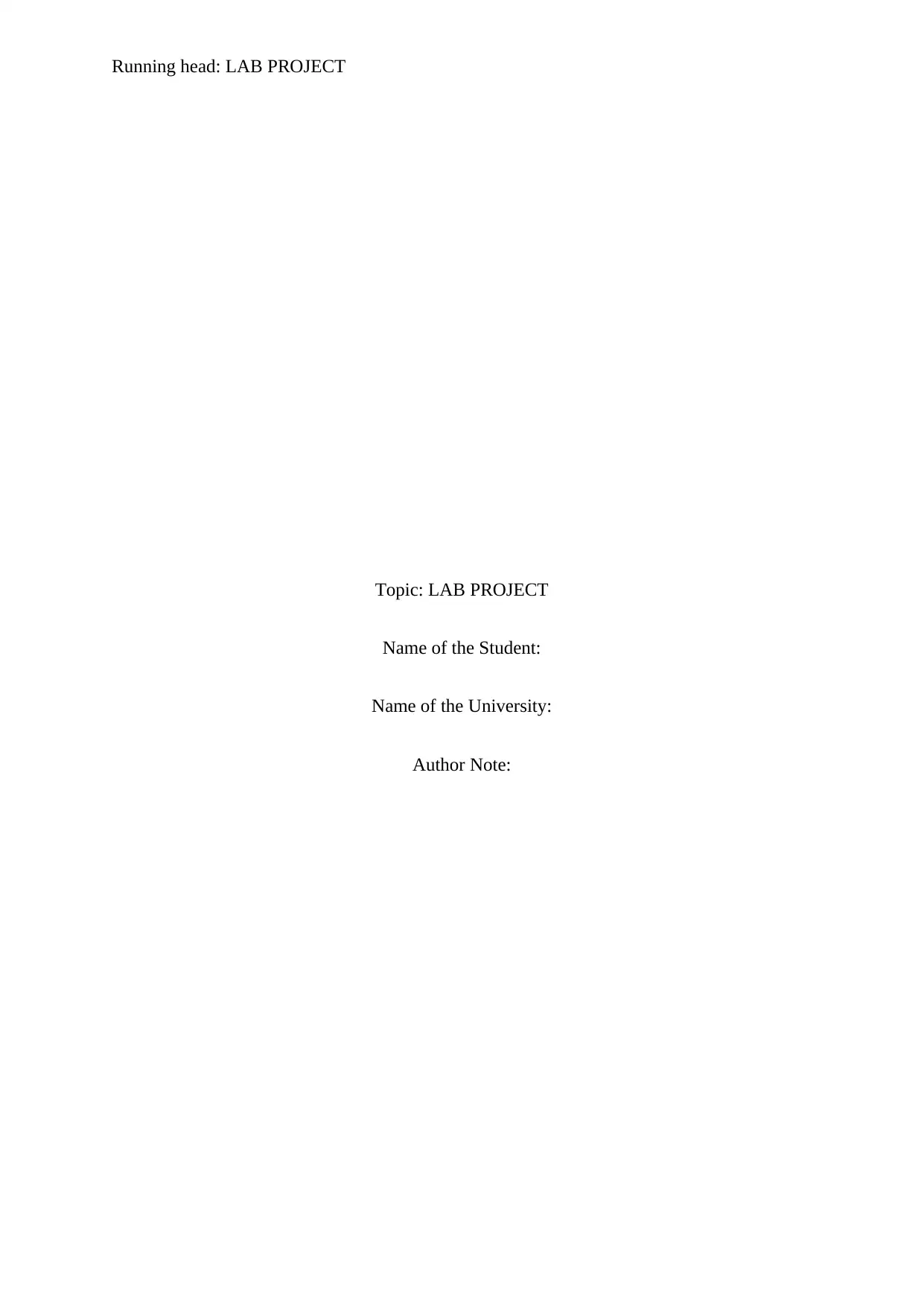
Running head: LAB PROJECT
Topic: LAB PROJECT
Name of the Student:
Name of the University:
Author Note:
Topic: LAB PROJECT
Name of the Student:
Name of the University:
Author Note:
Paraphrase This Document
Need a fresh take? Get an instant paraphrase of this document with our AI Paraphraser
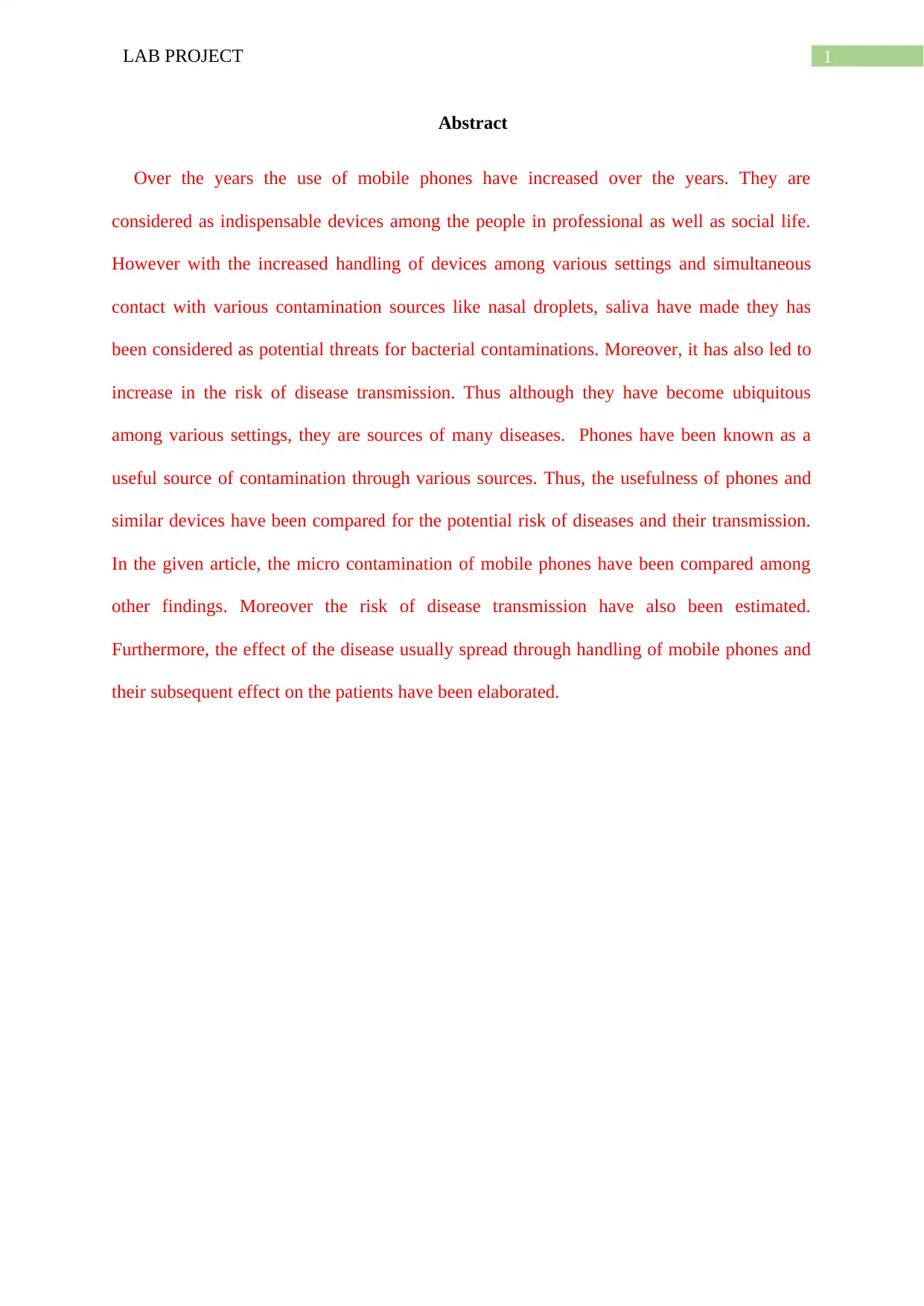
1LAB PROJECT
Abstract
Over the years the use of mobile phones have increased over the years. They are
considered as indispensable devices among the people in professional as well as social life.
However with the increased handling of devices among various settings and simultaneous
contact with various contamination sources like nasal droplets, saliva have made they has
been considered as potential threats for bacterial contaminations. Moreover, it has also led to
increase in the risk of disease transmission. Thus although they have become ubiquitous
among various settings, they are sources of many diseases. Phones have been known as a
useful source of contamination through various sources. Thus, the usefulness of phones and
similar devices have been compared for the potential risk of diseases and their transmission.
In the given article, the micro contamination of mobile phones have been compared among
other findings. Moreover the risk of disease transmission have also been estimated.
Furthermore, the effect of the disease usually spread through handling of mobile phones and
their subsequent effect on the patients have been elaborated.
Abstract
Over the years the use of mobile phones have increased over the years. They are
considered as indispensable devices among the people in professional as well as social life.
However with the increased handling of devices among various settings and simultaneous
contact with various contamination sources like nasal droplets, saliva have made they has
been considered as potential threats for bacterial contaminations. Moreover, it has also led to
increase in the risk of disease transmission. Thus although they have become ubiquitous
among various settings, they are sources of many diseases. Phones have been known as a
useful source of contamination through various sources. Thus, the usefulness of phones and
similar devices have been compared for the potential risk of diseases and their transmission.
In the given article, the micro contamination of mobile phones have been compared among
other findings. Moreover the risk of disease transmission have also been estimated.
Furthermore, the effect of the disease usually spread through handling of mobile phones and
their subsequent effect on the patients have been elaborated.
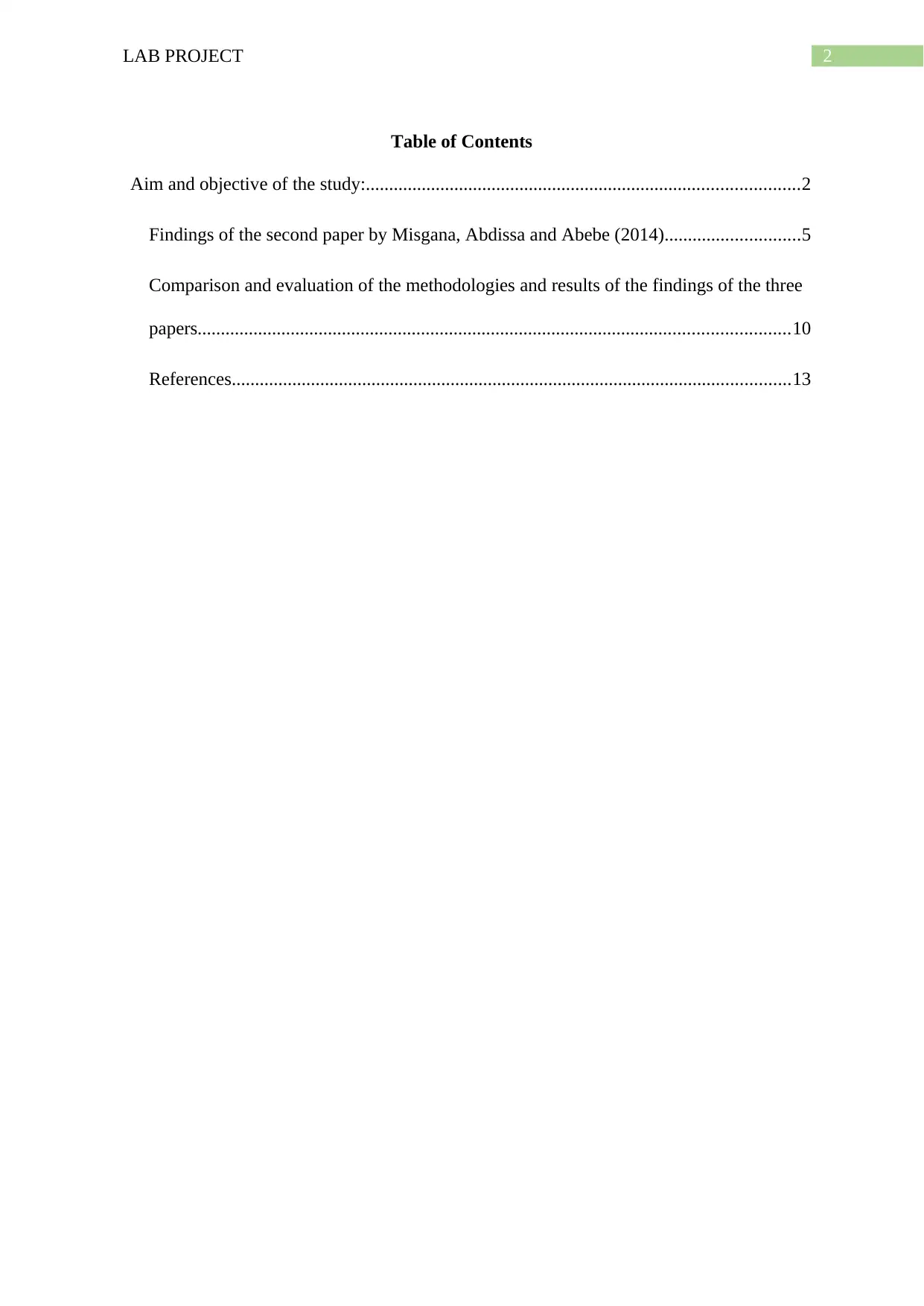
2LAB PROJECT
Table of Contents
Aim and objective of the study:.............................................................................................2
Findings of the second paper by Misgana, Abdissa and Abebe (2014).............................5
Comparison and evaluation of the methodologies and results of the findings of the three
papers...............................................................................................................................10
References........................................................................................................................13
Table of Contents
Aim and objective of the study:.............................................................................................2
Findings of the second paper by Misgana, Abdissa and Abebe (2014).............................5
Comparison and evaluation of the methodologies and results of the findings of the three
papers...............................................................................................................................10
References........................................................................................................................13
You're viewing a preview
Unlock full access by subscribing today!
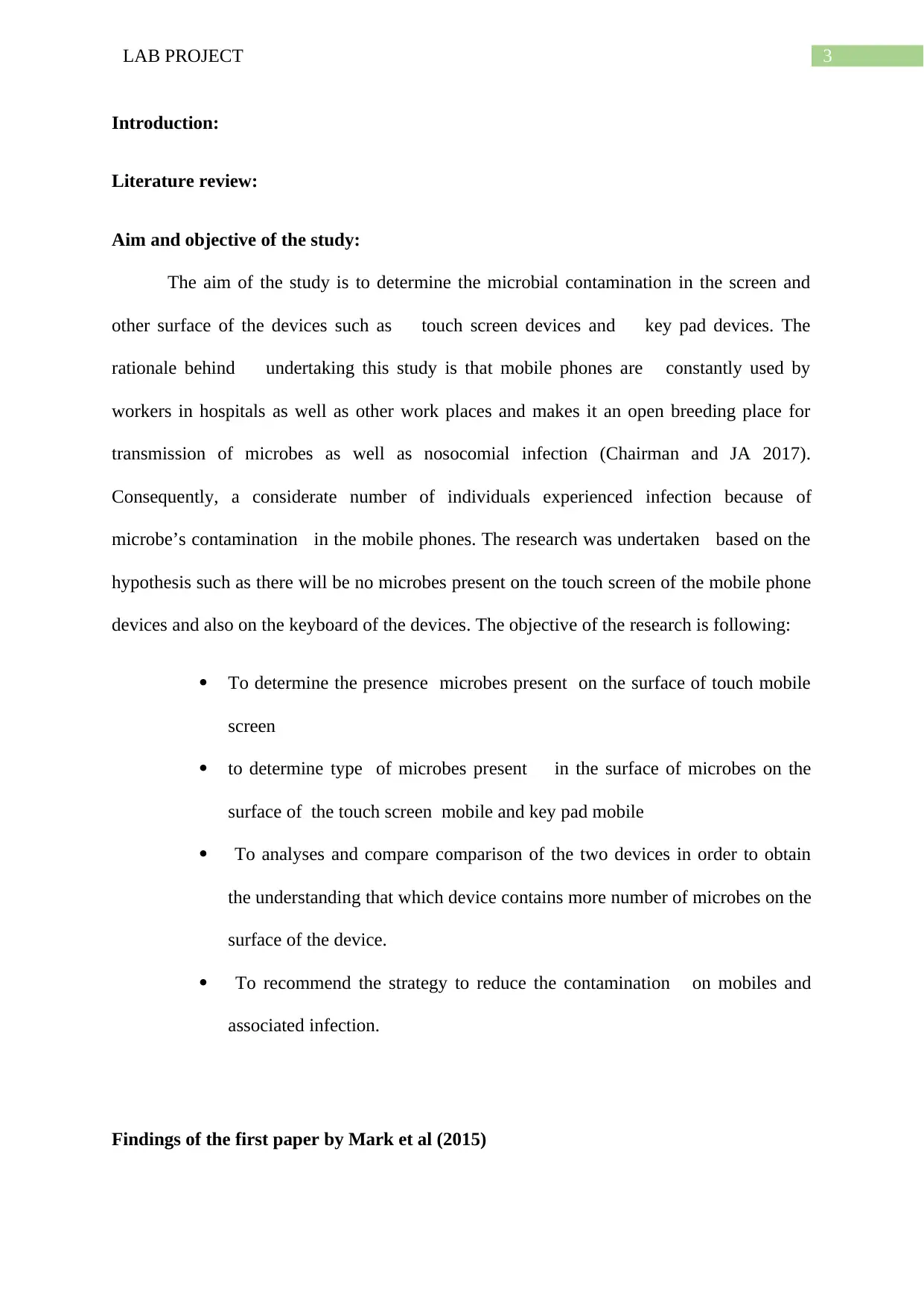
3LAB PROJECT
Introduction:
Literature review:
Aim and objective of the study:
The aim of the study is to determine the microbial contamination in the screen and
other surface of the devices such as touch screen devices and key pad devices. The
rationale behind undertaking this study is that mobile phones are constantly used by
workers in hospitals as well as other work places and makes it an open breeding place for
transmission of microbes as well as nosocomial infection (Chairman and JA 2017).
Consequently, a considerate number of individuals experienced infection because of
microbe’s contamination in the mobile phones. The research was undertaken based on the
hypothesis such as there will be no microbes present on the touch screen of the mobile phone
devices and also on the keyboard of the devices. The objective of the research is following:
To determine the presence microbes present on the surface of touch mobile
screen
to determine type of microbes present in the surface of microbes on the
surface of the touch screen mobile and key pad mobile
To analyses and compare comparison of the two devices in order to obtain
the understanding that which device contains more number of microbes on the
surface of the device.
To recommend the strategy to reduce the contamination on mobiles and
associated infection.
Findings of the first paper by Mark et al (2015)
Introduction:
Literature review:
Aim and objective of the study:
The aim of the study is to determine the microbial contamination in the screen and
other surface of the devices such as touch screen devices and key pad devices. The
rationale behind undertaking this study is that mobile phones are constantly used by
workers in hospitals as well as other work places and makes it an open breeding place for
transmission of microbes as well as nosocomial infection (Chairman and JA 2017).
Consequently, a considerate number of individuals experienced infection because of
microbe’s contamination in the mobile phones. The research was undertaken based on the
hypothesis such as there will be no microbes present on the touch screen of the mobile phone
devices and also on the keyboard of the devices. The objective of the research is following:
To determine the presence microbes present on the surface of touch mobile
screen
to determine type of microbes present in the surface of microbes on the
surface of the touch screen mobile and key pad mobile
To analyses and compare comparison of the two devices in order to obtain
the understanding that which device contains more number of microbes on the
surface of the device.
To recommend the strategy to reduce the contamination on mobiles and
associated infection.
Findings of the first paper by Mark et al (2015)
Paraphrase This Document
Need a fresh take? Get an instant paraphrase of this document with our AI Paraphraser
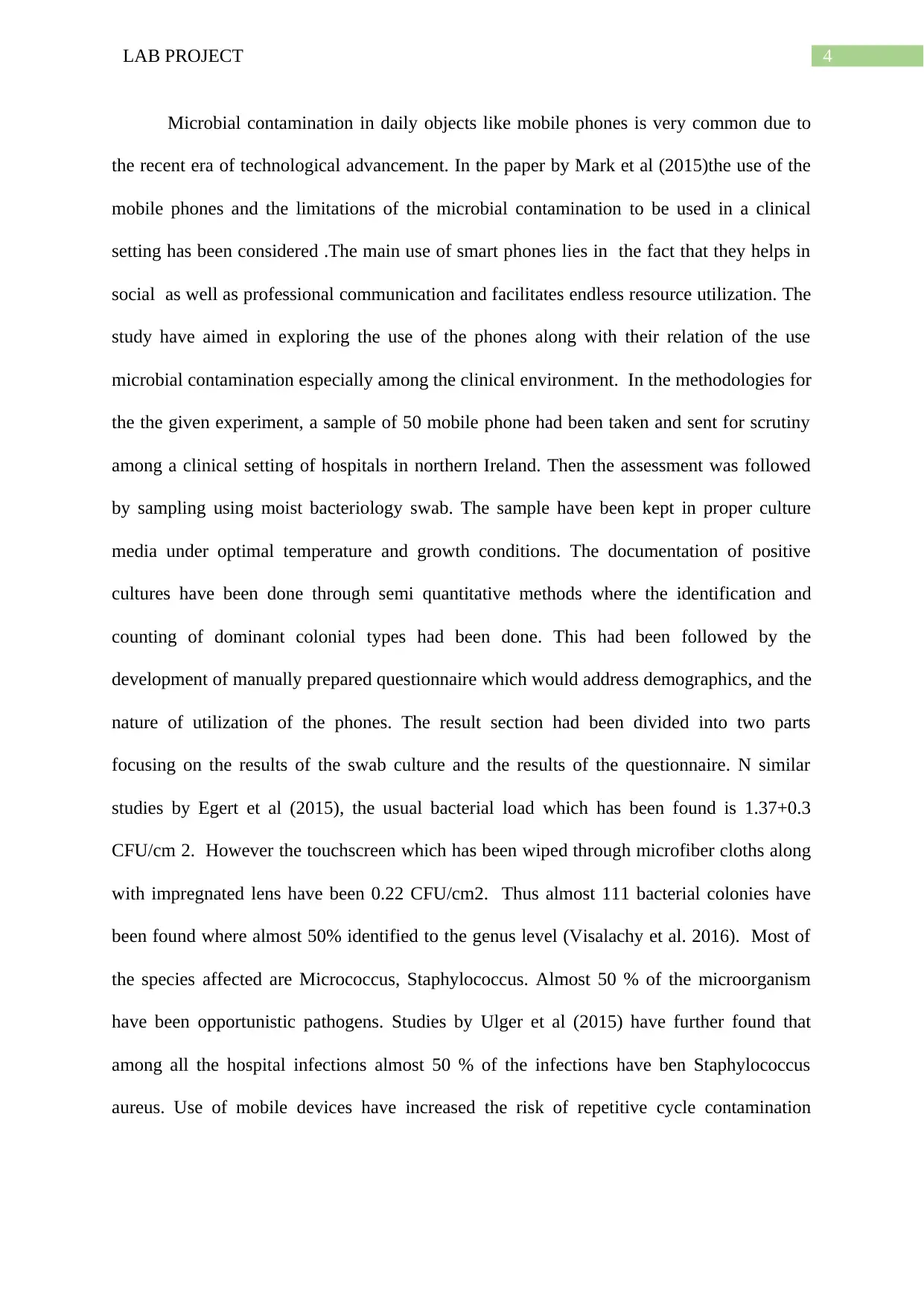
4LAB PROJECT
Microbial contamination in daily objects like mobile phones is very common due to
the recent era of technological advancement. In the paper by Mark et al (2015)the use of the
mobile phones and the limitations of the microbial contamination to be used in a clinical
setting has been considered .The main use of smart phones lies in the fact that they helps in
social as well as professional communication and facilitates endless resource utilization. The
study have aimed in exploring the use of the phones along with their relation of the use
microbial contamination especially among the clinical environment. In the methodologies for
the the given experiment, a sample of 50 mobile phone had been taken and sent for scrutiny
among a clinical setting of hospitals in northern Ireland. Then the assessment was followed
by sampling using moist bacteriology swab. The sample have been kept in proper culture
media under optimal temperature and growth conditions. The documentation of positive
cultures have been done through semi quantitative methods where the identification and
counting of dominant colonial types had been done. This had been followed by the
development of manually prepared questionnaire which would address demographics, and the
nature of utilization of the phones. The result section had been divided into two parts
focusing on the results of the swab culture and the results of the questionnaire. N similar
studies by Egert et al (2015), the usual bacterial load which has been found is 1.37+0.3
CFU/cm 2. However the touchscreen which has been wiped through microfiber cloths along
with impregnated lens have been 0.22 CFU/cm2. Thus almost 111 bacterial colonies have
been found where almost 50% identified to the genus level (Visalachy et al. 2016). Most of
the species affected are Micrococcus, Staphylococcus. Almost 50 % of the microorganism
have been opportunistic pathogens. Studies by Ulger et al (2015) have further found that
among all the hospital infections almost 50 % of the infections have ben Staphylococcus
aureus. Use of mobile devices have increased the risk of repetitive cycle contamination
Microbial contamination in daily objects like mobile phones is very common due to
the recent era of technological advancement. In the paper by Mark et al (2015)the use of the
mobile phones and the limitations of the microbial contamination to be used in a clinical
setting has been considered .The main use of smart phones lies in the fact that they helps in
social as well as professional communication and facilitates endless resource utilization. The
study have aimed in exploring the use of the phones along with their relation of the use
microbial contamination especially among the clinical environment. In the methodologies for
the the given experiment, a sample of 50 mobile phone had been taken and sent for scrutiny
among a clinical setting of hospitals in northern Ireland. Then the assessment was followed
by sampling using moist bacteriology swab. The sample have been kept in proper culture
media under optimal temperature and growth conditions. The documentation of positive
cultures have been done through semi quantitative methods where the identification and
counting of dominant colonial types had been done. This had been followed by the
development of manually prepared questionnaire which would address demographics, and the
nature of utilization of the phones. The result section had been divided into two parts
focusing on the results of the swab culture and the results of the questionnaire. N similar
studies by Egert et al (2015), the usual bacterial load which has been found is 1.37+0.3
CFU/cm 2. However the touchscreen which has been wiped through microfiber cloths along
with impregnated lens have been 0.22 CFU/cm2. Thus almost 111 bacterial colonies have
been found where almost 50% identified to the genus level (Visalachy et al. 2016). Most of
the species affected are Micrococcus, Staphylococcus. Almost 50 % of the microorganism
have been opportunistic pathogens. Studies by Ulger et al (2015) have further found that
among all the hospital infections almost 50 % of the infections have ben Staphylococcus
aureus. Use of mobile devices have increased the risk of repetitive cycle contamination
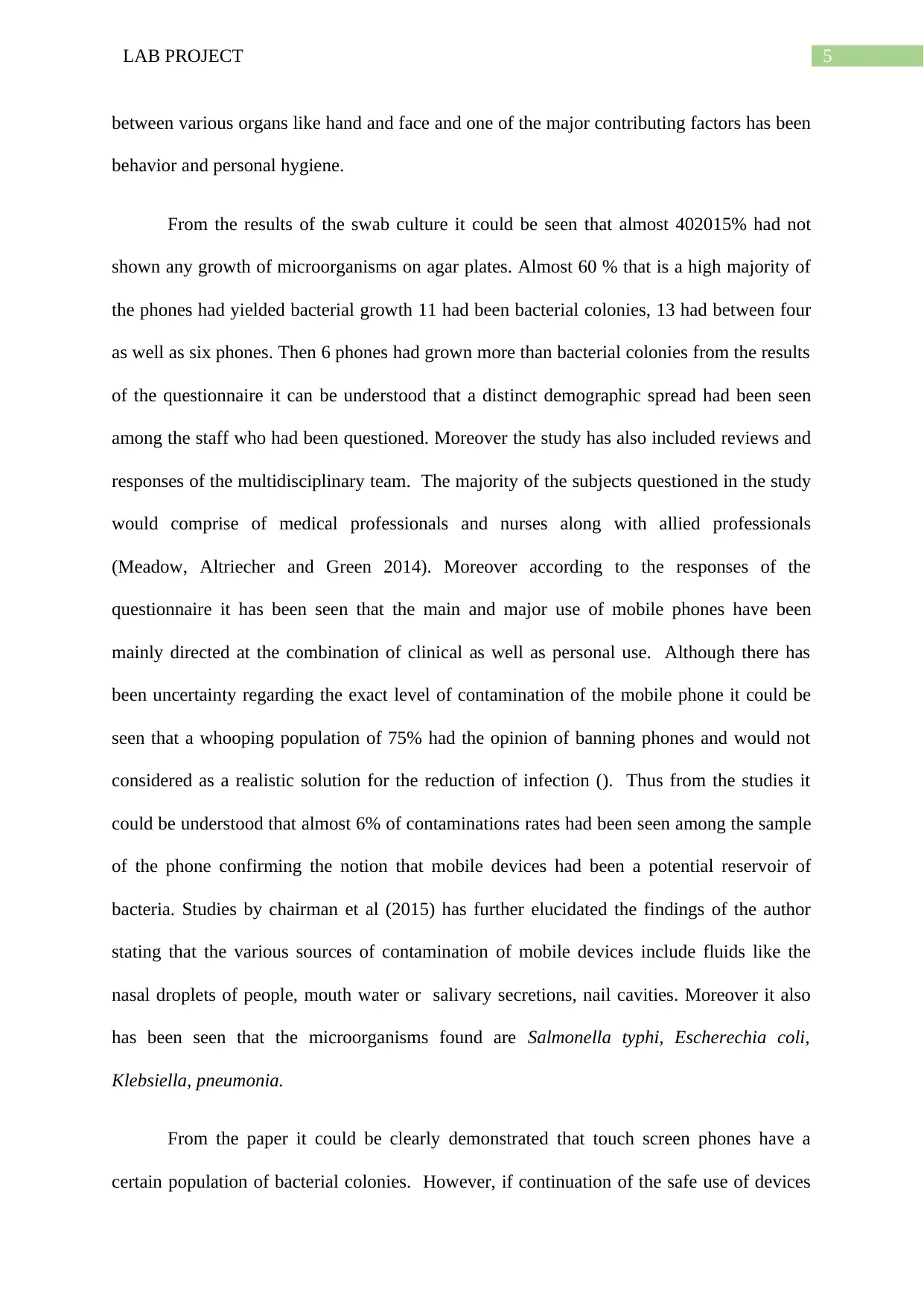
5LAB PROJECT
between various organs like hand and face and one of the major contributing factors has been
behavior and personal hygiene.
From the results of the swab culture it could be seen that almost 402015% had not
shown any growth of microorganisms on agar plates. Almost 60 % that is a high majority of
the phones had yielded bacterial growth 11 had been bacterial colonies, 13 had between four
as well as six phones. Then 6 phones had grown more than bacterial colonies from the results
of the questionnaire it can be understood that a distinct demographic spread had been seen
among the staff who had been questioned. Moreover the study has also included reviews and
responses of the multidisciplinary team. The majority of the subjects questioned in the study
would comprise of medical professionals and nurses along with allied professionals
(Meadow, Altriecher and Green 2014). Moreover according to the responses of the
questionnaire it has been seen that the main and major use of mobile phones have been
mainly directed at the combination of clinical as well as personal use. Although there has
been uncertainty regarding the exact level of contamination of the mobile phone it could be
seen that a whooping population of 75% had the opinion of banning phones and would not
considered as a realistic solution for the reduction of infection (). Thus from the studies it
could be understood that almost 6% of contaminations rates had been seen among the sample
of the phone confirming the notion that mobile devices had been a potential reservoir of
bacteria. Studies by chairman et al (2015) has further elucidated the findings of the author
stating that the various sources of contamination of mobile devices include fluids like the
nasal droplets of people, mouth water or salivary secretions, nail cavities. Moreover it also
has been seen that the microorganisms found are Salmonella typhi, Escherechia coli,
Klebsiella, pneumonia.
From the paper it could be clearly demonstrated that touch screen phones have a
certain population of bacterial colonies. However, if continuation of the safe use of devices
between various organs like hand and face and one of the major contributing factors has been
behavior and personal hygiene.
From the results of the swab culture it could be seen that almost 402015% had not
shown any growth of microorganisms on agar plates. Almost 60 % that is a high majority of
the phones had yielded bacterial growth 11 had been bacterial colonies, 13 had between four
as well as six phones. Then 6 phones had grown more than bacterial colonies from the results
of the questionnaire it can be understood that a distinct demographic spread had been seen
among the staff who had been questioned. Moreover the study has also included reviews and
responses of the multidisciplinary team. The majority of the subjects questioned in the study
would comprise of medical professionals and nurses along with allied professionals
(Meadow, Altriecher and Green 2014). Moreover according to the responses of the
questionnaire it has been seen that the main and major use of mobile phones have been
mainly directed at the combination of clinical as well as personal use. Although there has
been uncertainty regarding the exact level of contamination of the mobile phone it could be
seen that a whooping population of 75% had the opinion of banning phones and would not
considered as a realistic solution for the reduction of infection (). Thus from the studies it
could be understood that almost 6% of contaminations rates had been seen among the sample
of the phone confirming the notion that mobile devices had been a potential reservoir of
bacteria. Studies by chairman et al (2015) has further elucidated the findings of the author
stating that the various sources of contamination of mobile devices include fluids like the
nasal droplets of people, mouth water or salivary secretions, nail cavities. Moreover it also
has been seen that the microorganisms found are Salmonella typhi, Escherechia coli,
Klebsiella, pneumonia.
From the paper it could be clearly demonstrated that touch screen phones have a
certain population of bacterial colonies. However, if continuation of the safe use of devices
You're viewing a preview
Unlock full access by subscribing today!
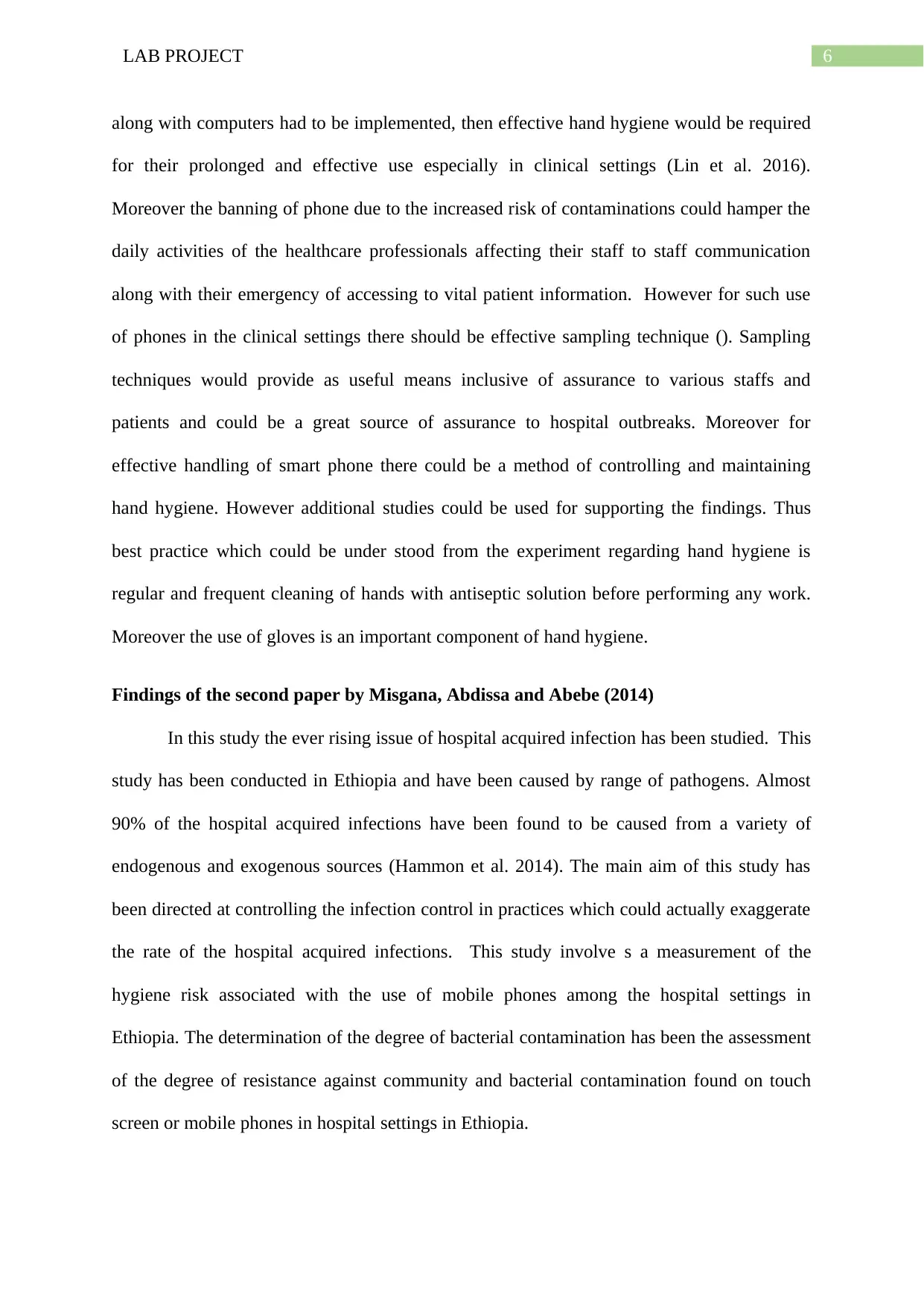
6LAB PROJECT
along with computers had to be implemented, then effective hand hygiene would be required
for their prolonged and effective use especially in clinical settings (Lin et al. 2016).
Moreover the banning of phone due to the increased risk of contaminations could hamper the
daily activities of the healthcare professionals affecting their staff to staff communication
along with their emergency of accessing to vital patient information. However for such use
of phones in the clinical settings there should be effective sampling technique (). Sampling
techniques would provide as useful means inclusive of assurance to various staffs and
patients and could be a great source of assurance to hospital outbreaks. Moreover for
effective handling of smart phone there could be a method of controlling and maintaining
hand hygiene. However additional studies could be used for supporting the findings. Thus
best practice which could be under stood from the experiment regarding hand hygiene is
regular and frequent cleaning of hands with antiseptic solution before performing any work.
Moreover the use of gloves is an important component of hand hygiene.
Findings of the second paper by Misgana, Abdissa and Abebe (2014)
In this study the ever rising issue of hospital acquired infection has been studied. This
study has been conducted in Ethiopia and have been caused by range of pathogens. Almost
90% of the hospital acquired infections have been found to be caused from a variety of
endogenous and exogenous sources (Hammon et al. 2014). The main aim of this study has
been directed at controlling the infection control in practices which could actually exaggerate
the rate of the hospital acquired infections. This study involve s a measurement of the
hygiene risk associated with the use of mobile phones among the hospital settings in
Ethiopia. The determination of the degree of bacterial contamination has been the assessment
of the degree of resistance against community and bacterial contamination found on touch
screen or mobile phones in hospital settings in Ethiopia.
along with computers had to be implemented, then effective hand hygiene would be required
for their prolonged and effective use especially in clinical settings (Lin et al. 2016).
Moreover the banning of phone due to the increased risk of contaminations could hamper the
daily activities of the healthcare professionals affecting their staff to staff communication
along with their emergency of accessing to vital patient information. However for such use
of phones in the clinical settings there should be effective sampling technique (). Sampling
techniques would provide as useful means inclusive of assurance to various staffs and
patients and could be a great source of assurance to hospital outbreaks. Moreover for
effective handling of smart phone there could be a method of controlling and maintaining
hand hygiene. However additional studies could be used for supporting the findings. Thus
best practice which could be under stood from the experiment regarding hand hygiene is
regular and frequent cleaning of hands with antiseptic solution before performing any work.
Moreover the use of gloves is an important component of hand hygiene.
Findings of the second paper by Misgana, Abdissa and Abebe (2014)
In this study the ever rising issue of hospital acquired infection has been studied. This
study has been conducted in Ethiopia and have been caused by range of pathogens. Almost
90% of the hospital acquired infections have been found to be caused from a variety of
endogenous and exogenous sources (Hammon et al. 2014). The main aim of this study has
been directed at controlling the infection control in practices which could actually exaggerate
the rate of the hospital acquired infections. This study involve s a measurement of the
hygiene risk associated with the use of mobile phones among the hospital settings in
Ethiopia. The determination of the degree of bacterial contamination has been the assessment
of the degree of resistance against community and bacterial contamination found on touch
screen or mobile phones in hospital settings in Ethiopia.
Paraphrase This Document
Need a fresh take? Get an instant paraphrase of this document with our AI Paraphraser
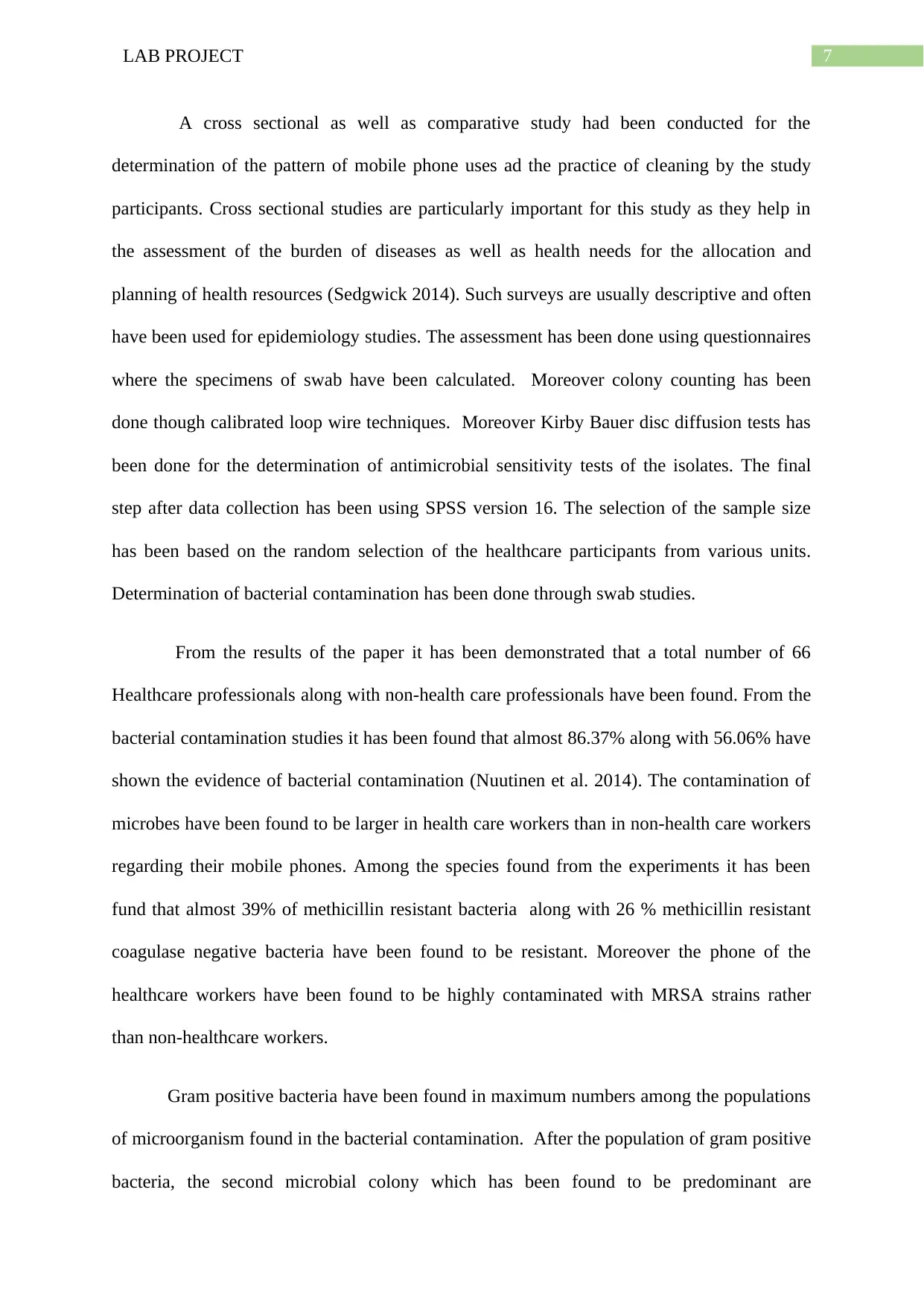
7LAB PROJECT
A cross sectional as well as comparative study had been conducted for the
determination of the pattern of mobile phone uses ad the practice of cleaning by the study
participants. Cross sectional studies are particularly important for this study as they help in
the assessment of the burden of diseases as well as health needs for the allocation and
planning of health resources (Sedgwick 2014). Such surveys are usually descriptive and often
have been used for epidemiology studies. The assessment has been done using questionnaires
where the specimens of swab have been calculated. Moreover colony counting has been
done though calibrated loop wire techniques. Moreover Kirby Bauer disc diffusion tests has
been done for the determination of antimicrobial sensitivity tests of the isolates. The final
step after data collection has been using SPSS version 16. The selection of the sample size
has been based on the random selection of the healthcare participants from various units.
Determination of bacterial contamination has been done through swab studies.
From the results of the paper it has been demonstrated that a total number of 66
Healthcare professionals along with non-health care professionals have been found. From the
bacterial contamination studies it has been found that almost 86.37% along with 56.06% have
shown the evidence of bacterial contamination (Nuutinen et al. 2014). The contamination of
microbes have been found to be larger in health care workers than in non-health care workers
regarding their mobile phones. Among the species found from the experiments it has been
fund that almost 39% of methicillin resistant bacteria along with 26 % methicillin resistant
coagulase negative bacteria have been found to be resistant. Moreover the phone of the
healthcare workers have been found to be highly contaminated with MRSA strains rather
than non-healthcare workers.
Gram positive bacteria have been found in maximum numbers among the populations
of microorganism found in the bacterial contamination. After the population of gram positive
bacteria, the second microbial colony which has been found to be predominant are
A cross sectional as well as comparative study had been conducted for the
determination of the pattern of mobile phone uses ad the practice of cleaning by the study
participants. Cross sectional studies are particularly important for this study as they help in
the assessment of the burden of diseases as well as health needs for the allocation and
planning of health resources (Sedgwick 2014). Such surveys are usually descriptive and often
have been used for epidemiology studies. The assessment has been done using questionnaires
where the specimens of swab have been calculated. Moreover colony counting has been
done though calibrated loop wire techniques. Moreover Kirby Bauer disc diffusion tests has
been done for the determination of antimicrobial sensitivity tests of the isolates. The final
step after data collection has been using SPSS version 16. The selection of the sample size
has been based on the random selection of the healthcare participants from various units.
Determination of bacterial contamination has been done through swab studies.
From the results of the paper it has been demonstrated that a total number of 66
Healthcare professionals along with non-health care professionals have been found. From the
bacterial contamination studies it has been found that almost 86.37% along with 56.06% have
shown the evidence of bacterial contamination (Nuutinen et al. 2014). The contamination of
microbes have been found to be larger in health care workers than in non-health care workers
regarding their mobile phones. Among the species found from the experiments it has been
fund that almost 39% of methicillin resistant bacteria along with 26 % methicillin resistant
coagulase negative bacteria have been found to be resistant. Moreover the phone of the
healthcare workers have been found to be highly contaminated with MRSA strains rather
than non-healthcare workers.
Gram positive bacteria have been found in maximum numbers among the populations
of microorganism found in the bacterial contamination. After the population of gram positive
bacteria, the second microbial colony which has been found to be predominant are
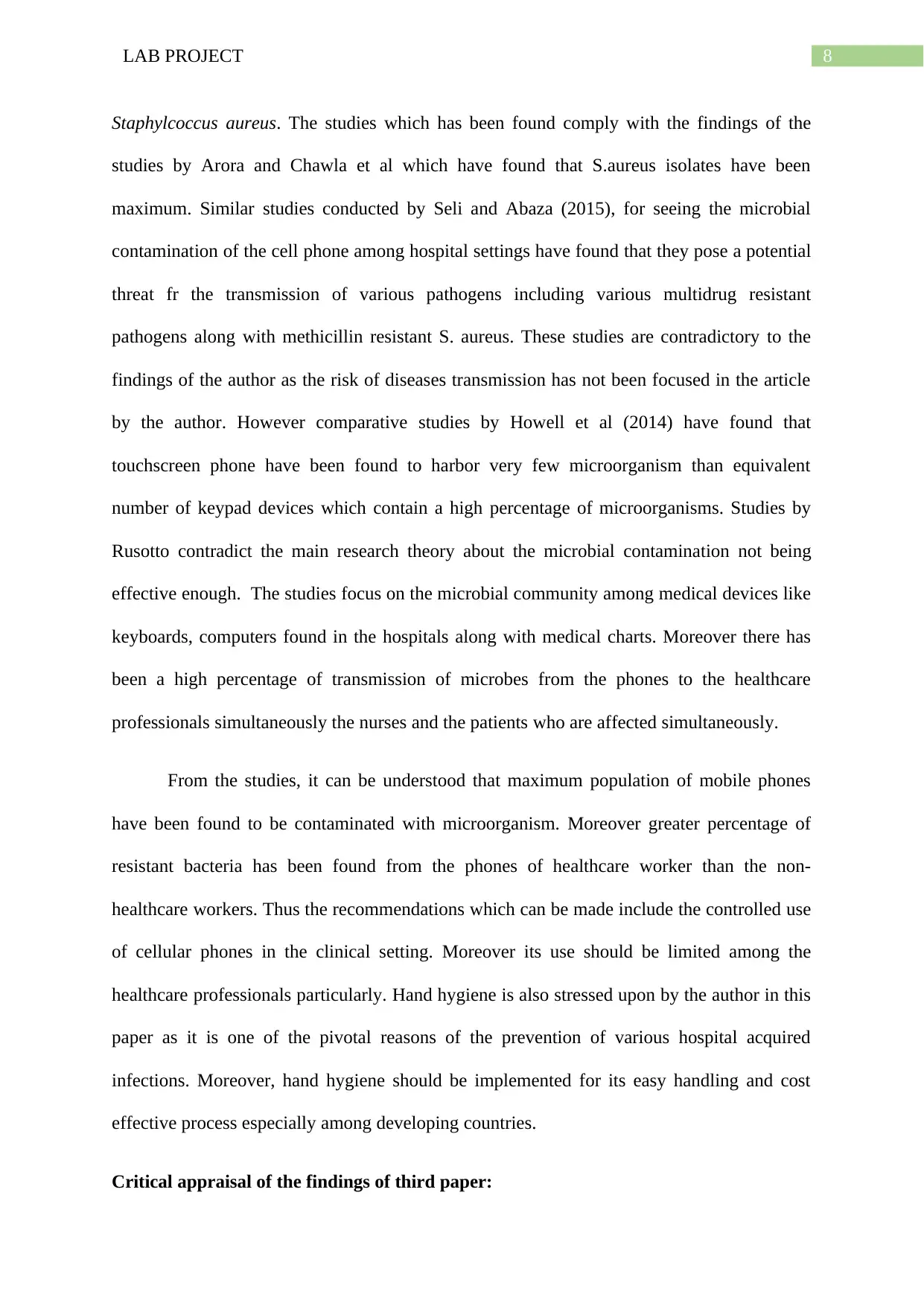
8LAB PROJECT
Staphylcoccus aureus. The studies which has been found comply with the findings of the
studies by Arora and Chawla et al which have found that S.aureus isolates have been
maximum. Similar studies conducted by Seli and Abaza (2015), for seeing the microbial
contamination of the cell phone among hospital settings have found that they pose a potential
threat fr the transmission of various pathogens including various multidrug resistant
pathogens along with methicillin resistant S. aureus. These studies are contradictory to the
findings of the author as the risk of diseases transmission has not been focused in the article
by the author. However comparative studies by Howell et al (2014) have found that
touchscreen phone have been found to harbor very few microorganism than equivalent
number of keypad devices which contain a high percentage of microorganisms. Studies by
Rusotto contradict the main research theory about the microbial contamination not being
effective enough. The studies focus on the microbial community among medical devices like
keyboards, computers found in the hospitals along with medical charts. Moreover there has
been a high percentage of transmission of microbes from the phones to the healthcare
professionals simultaneously the nurses and the patients who are affected simultaneously.
From the studies, it can be understood that maximum population of mobile phones
have been found to be contaminated with microorganism. Moreover greater percentage of
resistant bacteria has been found from the phones of healthcare worker than the non-
healthcare workers. Thus the recommendations which can be made include the controlled use
of cellular phones in the clinical setting. Moreover its use should be limited among the
healthcare professionals particularly. Hand hygiene is also stressed upon by the author in this
paper as it is one of the pivotal reasons of the prevention of various hospital acquired
infections. Moreover, hand hygiene should be implemented for its easy handling and cost
effective process especially among developing countries.
Critical appraisal of the findings of third paper:
Staphylcoccus aureus. The studies which has been found comply with the findings of the
studies by Arora and Chawla et al which have found that S.aureus isolates have been
maximum. Similar studies conducted by Seli and Abaza (2015), for seeing the microbial
contamination of the cell phone among hospital settings have found that they pose a potential
threat fr the transmission of various pathogens including various multidrug resistant
pathogens along with methicillin resistant S. aureus. These studies are contradictory to the
findings of the author as the risk of diseases transmission has not been focused in the article
by the author. However comparative studies by Howell et al (2014) have found that
touchscreen phone have been found to harbor very few microorganism than equivalent
number of keypad devices which contain a high percentage of microorganisms. Studies by
Rusotto contradict the main research theory about the microbial contamination not being
effective enough. The studies focus on the microbial community among medical devices like
keyboards, computers found in the hospitals along with medical charts. Moreover there has
been a high percentage of transmission of microbes from the phones to the healthcare
professionals simultaneously the nurses and the patients who are affected simultaneously.
From the studies, it can be understood that maximum population of mobile phones
have been found to be contaminated with microorganism. Moreover greater percentage of
resistant bacteria has been found from the phones of healthcare worker than the non-
healthcare workers. Thus the recommendations which can be made include the controlled use
of cellular phones in the clinical setting. Moreover its use should be limited among the
healthcare professionals particularly. Hand hygiene is also stressed upon by the author in this
paper as it is one of the pivotal reasons of the prevention of various hospital acquired
infections. Moreover, hand hygiene should be implemented for its easy handling and cost
effective process especially among developing countries.
Critical appraisal of the findings of third paper:
You're viewing a preview
Unlock full access by subscribing today!
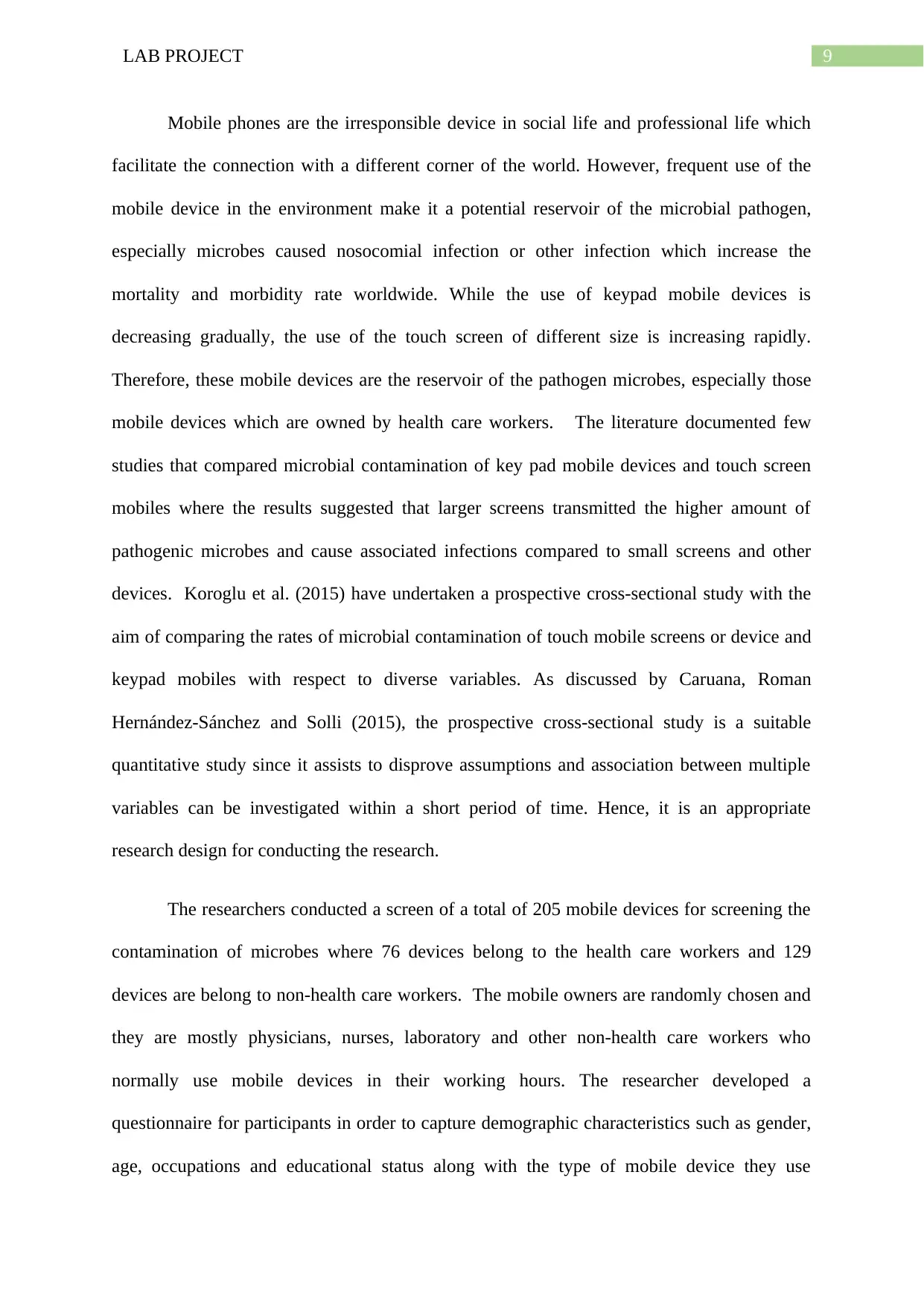
9LAB PROJECT
Mobile phones are the irresponsible device in social life and professional life which
facilitate the connection with a different corner of the world. However, frequent use of the
mobile device in the environment make it a potential reservoir of the microbial pathogen,
especially microbes caused nosocomial infection or other infection which increase the
mortality and morbidity rate worldwide. While the use of keypad mobile devices is
decreasing gradually, the use of the touch screen of different size is increasing rapidly.
Therefore, these mobile devices are the reservoir of the pathogen microbes, especially those
mobile devices which are owned by health care workers. The literature documented few
studies that compared microbial contamination of key pad mobile devices and touch screen
mobiles where the results suggested that larger screens transmitted the higher amount of
pathogenic microbes and cause associated infections compared to small screens and other
devices. Koroglu et al. (2015) have undertaken a prospective cross-sectional study with the
aim of comparing the rates of microbial contamination of touch mobile screens or device and
keypad mobiles with respect to diverse variables. As discussed by Caruana, Roman
Hernández-Sánchez and Solli (2015), the prospective cross-sectional study is a suitable
quantitative study since it assists to disprove assumptions and association between multiple
variables can be investigated within a short period of time. Hence, it is an appropriate
research design for conducting the research.
The researchers conducted a screen of a total of 205 mobile devices for screening the
contamination of microbes where 76 devices belong to the health care workers and 129
devices are belong to non-health care workers. The mobile owners are randomly chosen and
they are mostly physicians, nurses, laboratory and other non-health care workers who
normally use mobile devices in their working hours. The researcher developed a
questionnaire for participants in order to capture demographic characteristics such as gender,
age, occupations and educational status along with the type of mobile device they use
Mobile phones are the irresponsible device in social life and professional life which
facilitate the connection with a different corner of the world. However, frequent use of the
mobile device in the environment make it a potential reservoir of the microbial pathogen,
especially microbes caused nosocomial infection or other infection which increase the
mortality and morbidity rate worldwide. While the use of keypad mobile devices is
decreasing gradually, the use of the touch screen of different size is increasing rapidly.
Therefore, these mobile devices are the reservoir of the pathogen microbes, especially those
mobile devices which are owned by health care workers. The literature documented few
studies that compared microbial contamination of key pad mobile devices and touch screen
mobiles where the results suggested that larger screens transmitted the higher amount of
pathogenic microbes and cause associated infections compared to small screens and other
devices. Koroglu et al. (2015) have undertaken a prospective cross-sectional study with the
aim of comparing the rates of microbial contamination of touch mobile screens or device and
keypad mobiles with respect to diverse variables. As discussed by Caruana, Roman
Hernández-Sánchez and Solli (2015), the prospective cross-sectional study is a suitable
quantitative study since it assists to disprove assumptions and association between multiple
variables can be investigated within a short period of time. Hence, it is an appropriate
research design for conducting the research.
The researchers conducted a screen of a total of 205 mobile devices for screening the
contamination of microbes where 76 devices belong to the health care workers and 129
devices are belong to non-health care workers. The mobile owners are randomly chosen and
they are mostly physicians, nurses, laboratory and other non-health care workers who
normally use mobile devices in their working hours. The researcher developed a
questionnaire for participants in order to capture demographic characteristics such as gender,
age, occupations and educational status along with the type of mobile device they use
Paraphrase This Document
Need a fresh take? Get an instant paraphrase of this document with our AI Paraphraser
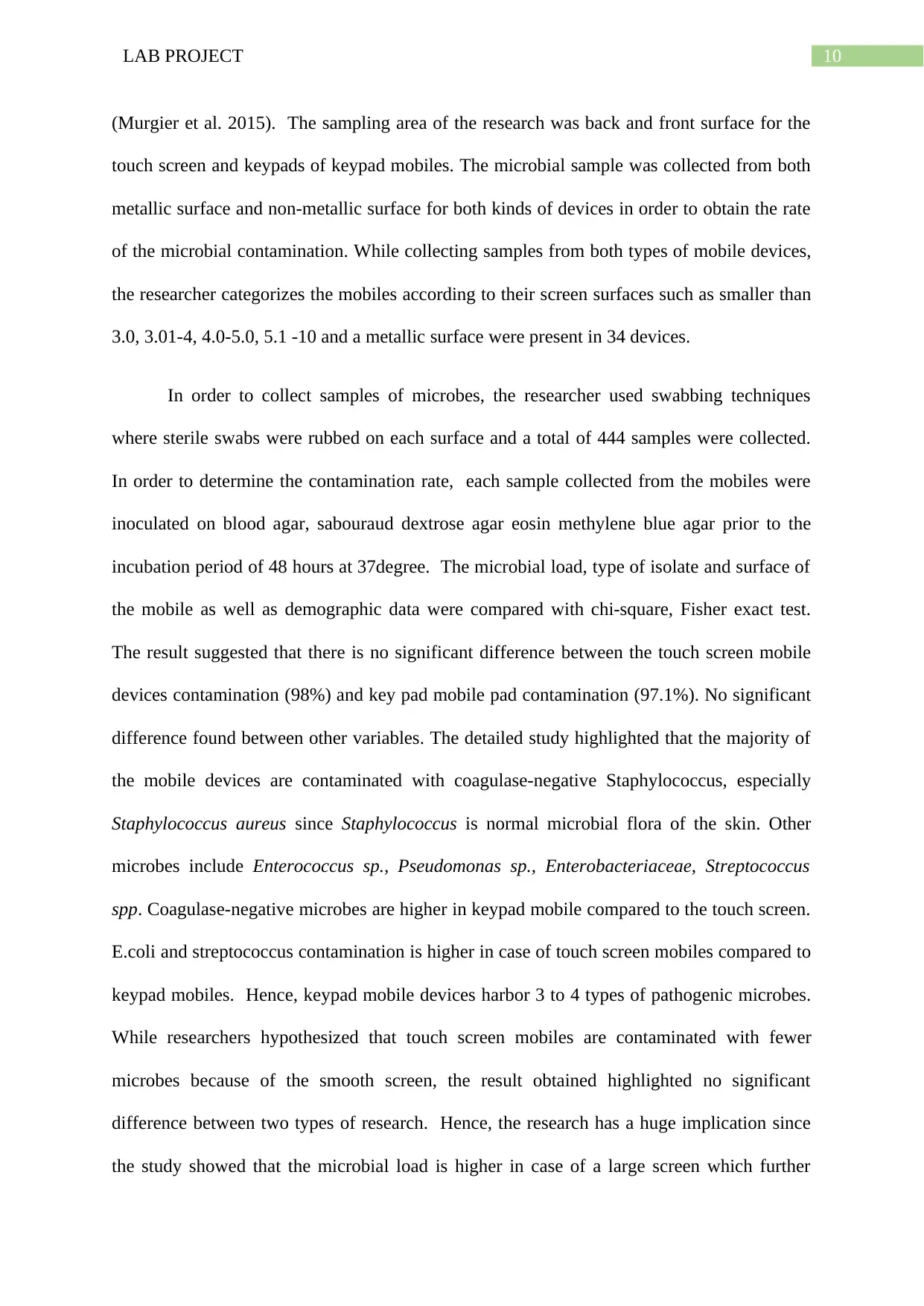
10LAB PROJECT
(Murgier et al. 2015). The sampling area of the research was back and front surface for the
touch screen and keypads of keypad mobiles. The microbial sample was collected from both
metallic surface and non-metallic surface for both kinds of devices in order to obtain the rate
of the microbial contamination. While collecting samples from both types of mobile devices,
the researcher categorizes the mobiles according to their screen surfaces such as smaller than
3.0, 3.01-4, 4.0-5.0, 5.1 -10 and a metallic surface were present in 34 devices.
In order to collect samples of microbes, the researcher used swabbing techniques
where sterile swabs were rubbed on each surface and a total of 444 samples were collected.
In order to determine the contamination rate, each sample collected from the mobiles were
inoculated on blood agar, sabouraud dextrose agar eosin methylene blue agar prior to the
incubation period of 48 hours at 37degree. The microbial load, type of isolate and surface of
the mobile as well as demographic data were compared with chi-square, Fisher exact test.
The result suggested that there is no significant difference between the touch screen mobile
devices contamination (98%) and key pad mobile pad contamination (97.1%). No significant
difference found between other variables. The detailed study highlighted that the majority of
the mobile devices are contaminated with coagulase-negative Staphylococcus, especially
Staphylococcus aureus since Staphylococcus is normal microbial flora of the skin. Other
microbes include Enterococcus sp., Pseudomonas sp., Enterobacteriaceae, Streptococcus
spp. Coagulase-negative microbes are higher in keypad mobile compared to the touch screen.
E.coli and streptococcus contamination is higher in case of touch screen mobiles compared to
keypad mobiles. Hence, keypad mobile devices harbor 3 to 4 types of pathogenic microbes.
While researchers hypothesized that touch screen mobiles are contaminated with fewer
microbes because of the smooth screen, the result obtained highlighted no significant
difference between two types of research. Hence, the research has a huge implication since
the study showed that the microbial load is higher in case of a large screen which further
(Murgier et al. 2015). The sampling area of the research was back and front surface for the
touch screen and keypads of keypad mobiles. The microbial sample was collected from both
metallic surface and non-metallic surface for both kinds of devices in order to obtain the rate
of the microbial contamination. While collecting samples from both types of mobile devices,
the researcher categorizes the mobiles according to their screen surfaces such as smaller than
3.0, 3.01-4, 4.0-5.0, 5.1 -10 and a metallic surface were present in 34 devices.
In order to collect samples of microbes, the researcher used swabbing techniques
where sterile swabs were rubbed on each surface and a total of 444 samples were collected.
In order to determine the contamination rate, each sample collected from the mobiles were
inoculated on blood agar, sabouraud dextrose agar eosin methylene blue agar prior to the
incubation period of 48 hours at 37degree. The microbial load, type of isolate and surface of
the mobile as well as demographic data were compared with chi-square, Fisher exact test.
The result suggested that there is no significant difference between the touch screen mobile
devices contamination (98%) and key pad mobile pad contamination (97.1%). No significant
difference found between other variables. The detailed study highlighted that the majority of
the mobile devices are contaminated with coagulase-negative Staphylococcus, especially
Staphylococcus aureus since Staphylococcus is normal microbial flora of the skin. Other
microbes include Enterococcus sp., Pseudomonas sp., Enterobacteriaceae, Streptococcus
spp. Coagulase-negative microbes are higher in keypad mobile compared to the touch screen.
E.coli and streptococcus contamination is higher in case of touch screen mobiles compared to
keypad mobiles. Hence, keypad mobile devices harbor 3 to 4 types of pathogenic microbes.
While researchers hypothesized that touch screen mobiles are contaminated with fewer
microbes because of the smooth screen, the result obtained highlighted no significant
difference between two types of research. Hence, the research has a huge implication since
the study showed that the microbial load is higher in case of a large screen which further
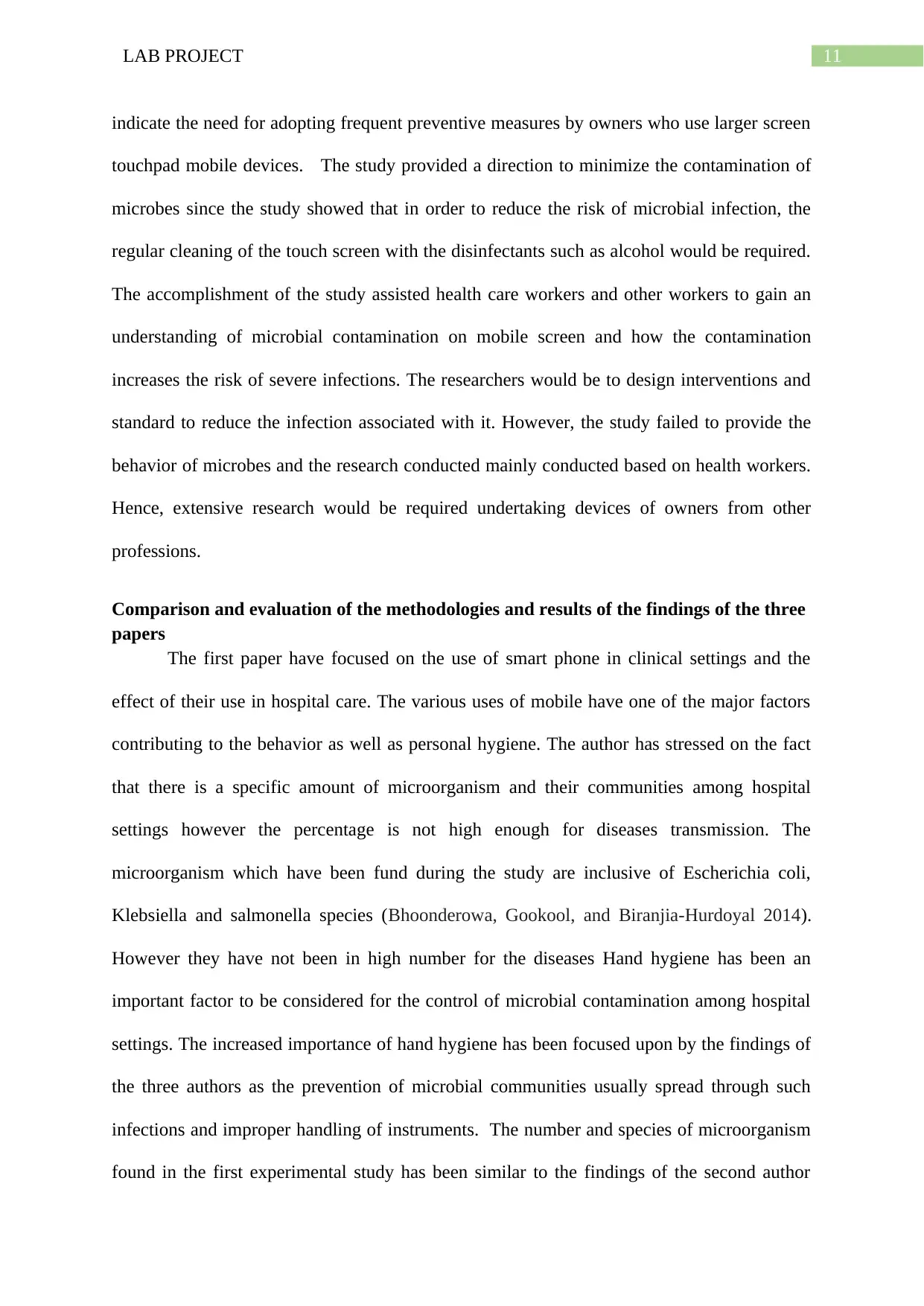
11LAB PROJECT
indicate the need for adopting frequent preventive measures by owners who use larger screen
touchpad mobile devices. The study provided a direction to minimize the contamination of
microbes since the study showed that in order to reduce the risk of microbial infection, the
regular cleaning of the touch screen with the disinfectants such as alcohol would be required.
The accomplishment of the study assisted health care workers and other workers to gain an
understanding of microbial contamination on mobile screen and how the contamination
increases the risk of severe infections. The researchers would be to design interventions and
standard to reduce the infection associated with it. However, the study failed to provide the
behavior of microbes and the research conducted mainly conducted based on health workers.
Hence, extensive research would be required undertaking devices of owners from other
professions.
Comparison and evaluation of the methodologies and results of the findings of the three
papers
The first paper have focused on the use of smart phone in clinical settings and the
effect of their use in hospital care. The various uses of mobile have one of the major factors
contributing to the behavior as well as personal hygiene. The author has stressed on the fact
that there is a specific amount of microorganism and their communities among hospital
settings however the percentage is not high enough for diseases transmission. The
microorganism which have been fund during the study are inclusive of Escherichia coli,
Klebsiella and salmonella species (Bhoonderowa, Gookool, and Biranjia-Hurdoyal 2014).
However they have not been in high number for the diseases Hand hygiene has been an
important factor to be considered for the control of microbial contamination among hospital
settings. The increased importance of hand hygiene has been focused upon by the findings of
the three authors as the prevention of microbial communities usually spread through such
infections and improper handling of instruments. The number and species of microorganism
found in the first experimental study has been similar to the findings of the second author
indicate the need for adopting frequent preventive measures by owners who use larger screen
touchpad mobile devices. The study provided a direction to minimize the contamination of
microbes since the study showed that in order to reduce the risk of microbial infection, the
regular cleaning of the touch screen with the disinfectants such as alcohol would be required.
The accomplishment of the study assisted health care workers and other workers to gain an
understanding of microbial contamination on mobile screen and how the contamination
increases the risk of severe infections. The researchers would be to design interventions and
standard to reduce the infection associated with it. However, the study failed to provide the
behavior of microbes and the research conducted mainly conducted based on health workers.
Hence, extensive research would be required undertaking devices of owners from other
professions.
Comparison and evaluation of the methodologies and results of the findings of the three
papers
The first paper have focused on the use of smart phone in clinical settings and the
effect of their use in hospital care. The various uses of mobile have one of the major factors
contributing to the behavior as well as personal hygiene. The author has stressed on the fact
that there is a specific amount of microorganism and their communities among hospital
settings however the percentage is not high enough for diseases transmission. The
microorganism which have been fund during the study are inclusive of Escherichia coli,
Klebsiella and salmonella species (Bhoonderowa, Gookool, and Biranjia-Hurdoyal 2014).
However they have not been in high number for the diseases Hand hygiene has been an
important factor to be considered for the control of microbial contamination among hospital
settings. The increased importance of hand hygiene has been focused upon by the findings of
the three authors as the prevention of microbial communities usually spread through such
infections and improper handling of instruments. The number and species of microorganism
found in the first experimental study has been similar to the findings of the second author
You're viewing a preview
Unlock full access by subscribing today!
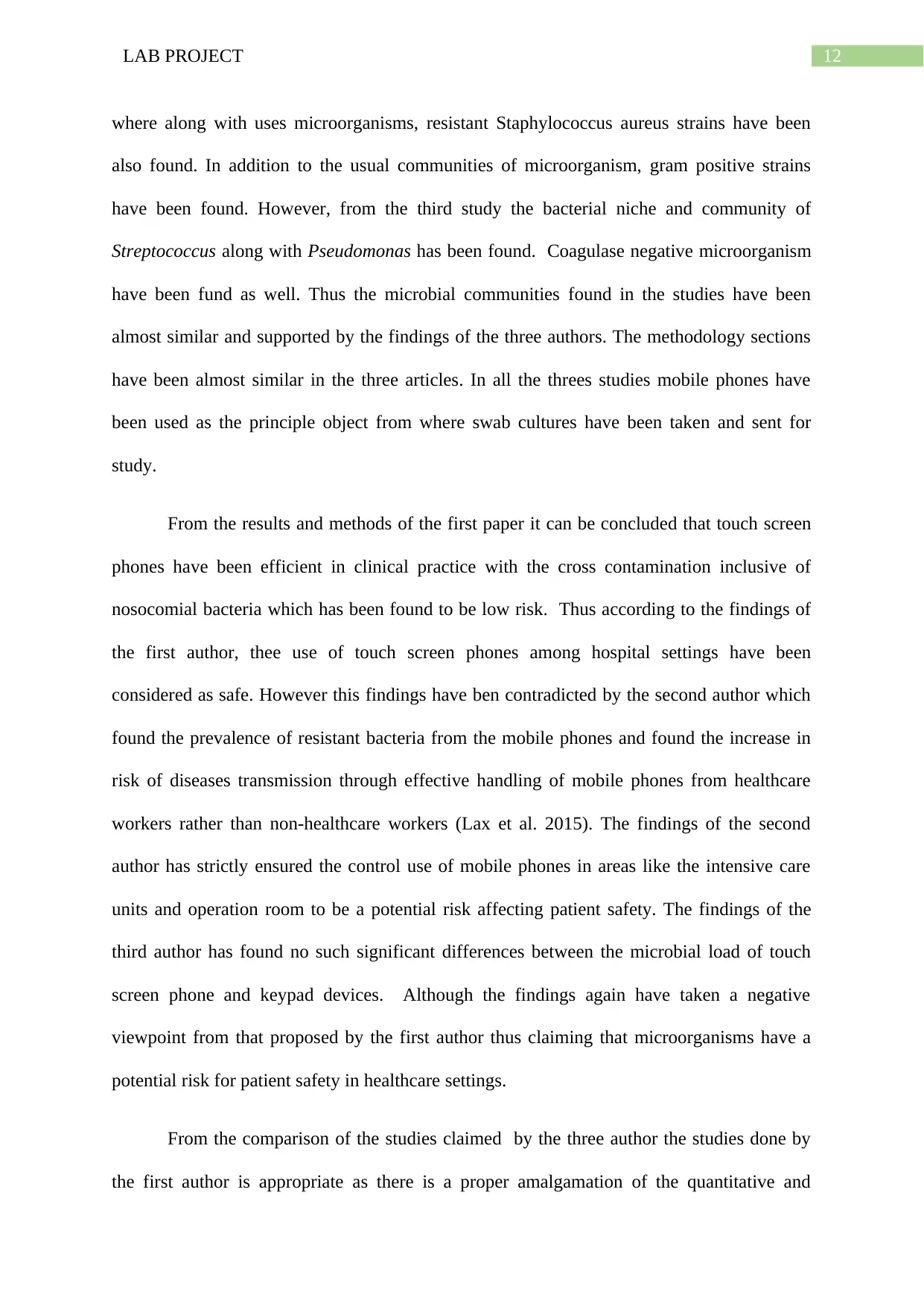
12LAB PROJECT
where along with uses microorganisms, resistant Staphylococcus aureus strains have been
also found. In addition to the usual communities of microorganism, gram positive strains
have been found. However, from the third study the bacterial niche and community of
Streptococcus along with Pseudomonas has been found. Coagulase negative microorganism
have been fund as well. Thus the microbial communities found in the studies have been
almost similar and supported by the findings of the three authors. The methodology sections
have been almost similar in the three articles. In all the threes studies mobile phones have
been used as the principle object from where swab cultures have been taken and sent for
study.
From the results and methods of the first paper it can be concluded that touch screen
phones have been efficient in clinical practice with the cross contamination inclusive of
nosocomial bacteria which has been found to be low risk. Thus according to the findings of
the first author, thee use of touch screen phones among hospital settings have been
considered as safe. However this findings have ben contradicted by the second author which
found the prevalence of resistant bacteria from the mobile phones and found the increase in
risk of diseases transmission through effective handling of mobile phones from healthcare
workers rather than non-healthcare workers (Lax et al. 2015). The findings of the second
author has strictly ensured the control use of mobile phones in areas like the intensive care
units and operation room to be a potential risk affecting patient safety. The findings of the
third author has found no such significant differences between the microbial load of touch
screen phone and keypad devices. Although the findings again have taken a negative
viewpoint from that proposed by the first author thus claiming that microorganisms have a
potential risk for patient safety in healthcare settings.
From the comparison of the studies claimed by the three author the studies done by
the first author is appropriate as there is a proper amalgamation of the quantitative and
where along with uses microorganisms, resistant Staphylococcus aureus strains have been
also found. In addition to the usual communities of microorganism, gram positive strains
have been found. However, from the third study the bacterial niche and community of
Streptococcus along with Pseudomonas has been found. Coagulase negative microorganism
have been fund as well. Thus the microbial communities found in the studies have been
almost similar and supported by the findings of the three authors. The methodology sections
have been almost similar in the three articles. In all the threes studies mobile phones have
been used as the principle object from where swab cultures have been taken and sent for
study.
From the results and methods of the first paper it can be concluded that touch screen
phones have been efficient in clinical practice with the cross contamination inclusive of
nosocomial bacteria which has been found to be low risk. Thus according to the findings of
the first author, thee use of touch screen phones among hospital settings have been
considered as safe. However this findings have ben contradicted by the second author which
found the prevalence of resistant bacteria from the mobile phones and found the increase in
risk of diseases transmission through effective handling of mobile phones from healthcare
workers rather than non-healthcare workers (Lax et al. 2015). The findings of the second
author has strictly ensured the control use of mobile phones in areas like the intensive care
units and operation room to be a potential risk affecting patient safety. The findings of the
third author has found no such significant differences between the microbial load of touch
screen phone and keypad devices. Although the findings again have taken a negative
viewpoint from that proposed by the first author thus claiming that microorganisms have a
potential risk for patient safety in healthcare settings.
From the comparison of the studies claimed by the three author the studies done by
the first author is appropriate as there is a proper amalgamation of the quantitative and
Paraphrase This Document
Need a fresh take? Get an instant paraphrase of this document with our AI Paraphraser

13LAB PROJECT
qualitative study methods aimed at finding the microbial load in the swabs collected from
touch screen phones. Moreover the methods have been precise and the justifications for the
research design has been given appropriately. Thus the above findings throw light on the fact
the there is a district microbial population and the microorganism related to the handling of
touch screen phones which should be kept under control through effective hand hygiene.
qualitative study methods aimed at finding the microbial load in the swabs collected from
touch screen phones. Moreover the methods have been precise and the justifications for the
research design has been given appropriately. Thus the above findings throw light on the fact
the there is a district microbial population and the microorganism related to the handling of
touch screen phones which should be kept under control through effective hand hygiene.
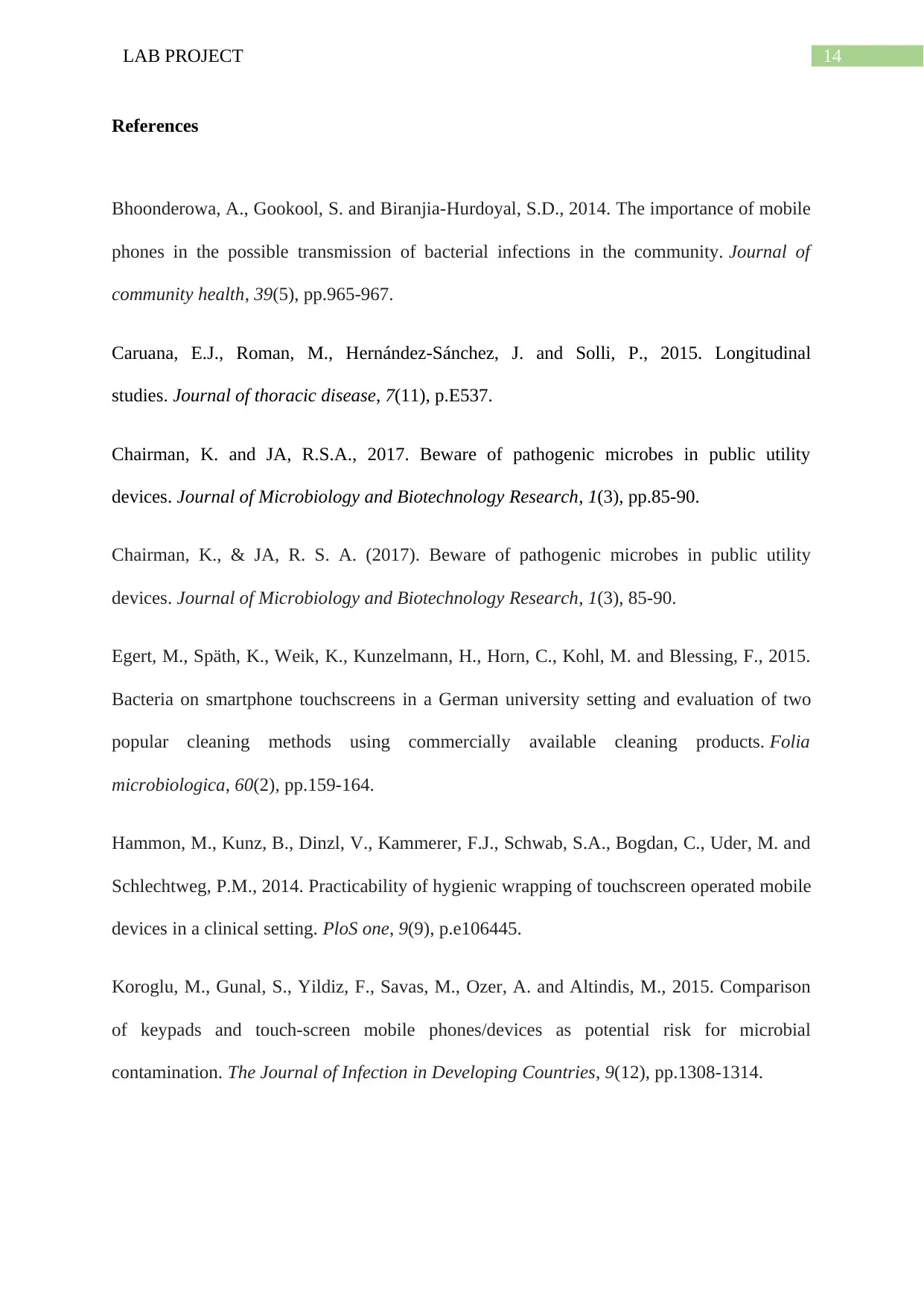
14LAB PROJECT
References
Bhoonderowa, A., Gookool, S. and Biranjia-Hurdoyal, S.D., 2014. The importance of mobile
phones in the possible transmission of bacterial infections in the community. Journal of
community health, 39(5), pp.965-967.
Caruana, E.J., Roman, M., Hernández-Sánchez, J. and Solli, P., 2015. Longitudinal
studies. Journal of thoracic disease, 7(11), p.E537.
Chairman, K. and JA, R.S.A., 2017. Beware of pathogenic microbes in public utility
devices. Journal of Microbiology and Biotechnology Research, 1(3), pp.85-90.
Chairman, K., & JA, R. S. A. (2017). Beware of pathogenic microbes in public utility
devices. Journal of Microbiology and Biotechnology Research, 1(3), 85-90.
Egert, M., Späth, K., Weik, K., Kunzelmann, H., Horn, C., Kohl, M. and Blessing, F., 2015.
Bacteria on smartphone touchscreens in a German university setting and evaluation of two
popular cleaning methods using commercially available cleaning products. Folia
microbiologica, 60(2), pp.159-164.
Hammon, M., Kunz, B., Dinzl, V., Kammerer, F.J., Schwab, S.A., Bogdan, C., Uder, M. and
Schlechtweg, P.M., 2014. Practicability of hygienic wrapping of touchscreen operated mobile
devices in a clinical setting. PloS one, 9(9), p.e106445.
Koroglu, M., Gunal, S., Yildiz, F., Savas, M., Ozer, A. and Altindis, M., 2015. Comparison
of keypads and touch-screen mobile phones/devices as potential risk for microbial
contamination. The Journal of Infection in Developing Countries, 9(12), pp.1308-1314.
References
Bhoonderowa, A., Gookool, S. and Biranjia-Hurdoyal, S.D., 2014. The importance of mobile
phones in the possible transmission of bacterial infections in the community. Journal of
community health, 39(5), pp.965-967.
Caruana, E.J., Roman, M., Hernández-Sánchez, J. and Solli, P., 2015. Longitudinal
studies. Journal of thoracic disease, 7(11), p.E537.
Chairman, K. and JA, R.S.A., 2017. Beware of pathogenic microbes in public utility
devices. Journal of Microbiology and Biotechnology Research, 1(3), pp.85-90.
Chairman, K., & JA, R. S. A. (2017). Beware of pathogenic microbes in public utility
devices. Journal of Microbiology and Biotechnology Research, 1(3), 85-90.
Egert, M., Späth, K., Weik, K., Kunzelmann, H., Horn, C., Kohl, M. and Blessing, F., 2015.
Bacteria on smartphone touchscreens in a German university setting and evaluation of two
popular cleaning methods using commercially available cleaning products. Folia
microbiologica, 60(2), pp.159-164.
Hammon, M., Kunz, B., Dinzl, V., Kammerer, F.J., Schwab, S.A., Bogdan, C., Uder, M. and
Schlechtweg, P.M., 2014. Practicability of hygienic wrapping of touchscreen operated mobile
devices in a clinical setting. PloS one, 9(9), p.e106445.
Koroglu, M., Gunal, S., Yildiz, F., Savas, M., Ozer, A. and Altindis, M., 2015. Comparison
of keypads and touch-screen mobile phones/devices as potential risk for microbial
contamination. The Journal of Infection in Developing Countries, 9(12), pp.1308-1314.
You're viewing a preview
Unlock full access by subscribing today!
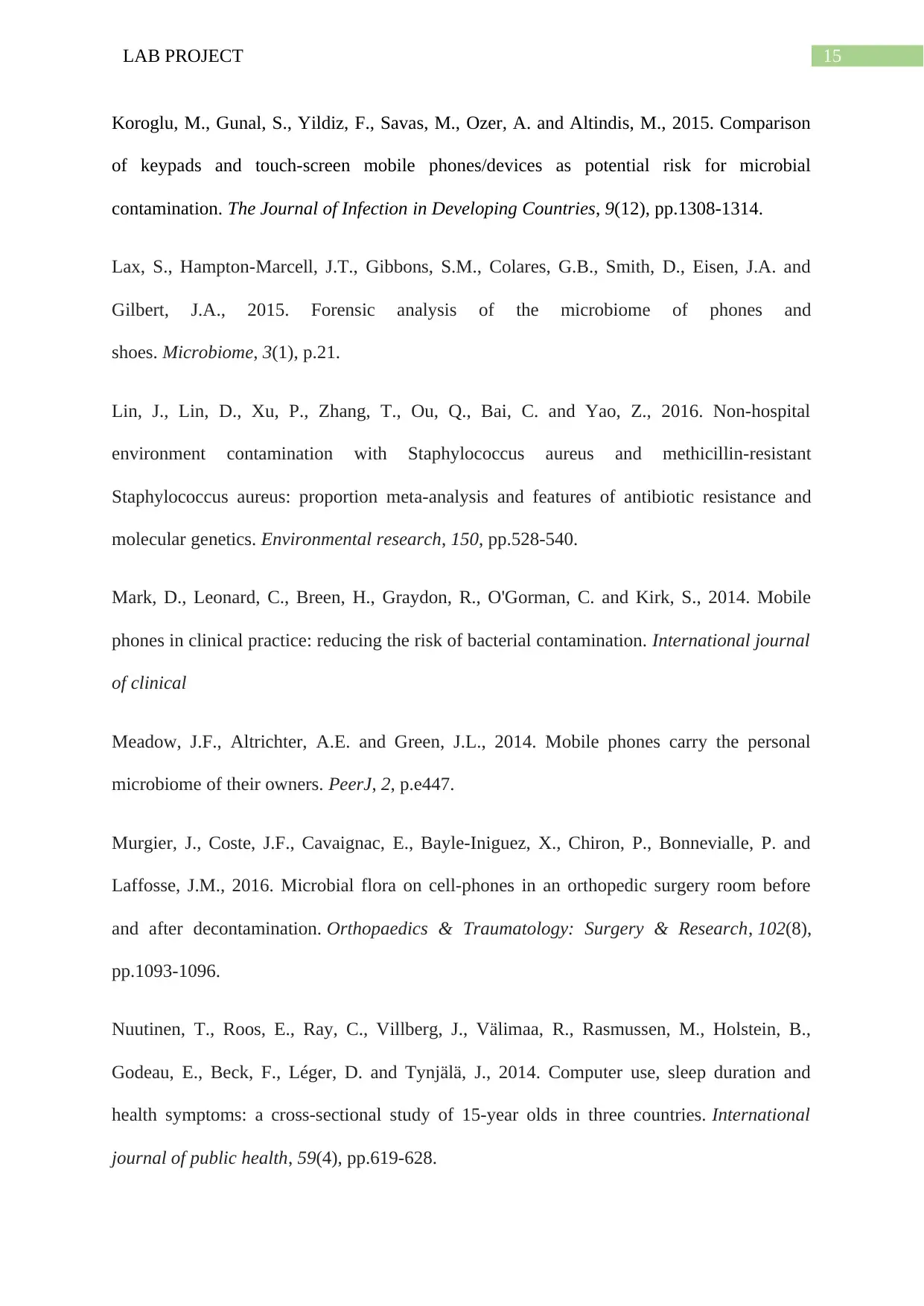
15LAB PROJECT
Koroglu, M., Gunal, S., Yildiz, F., Savas, M., Ozer, A. and Altindis, M., 2015. Comparison
of keypads and touch-screen mobile phones/devices as potential risk for microbial
contamination. The Journal of Infection in Developing Countries, 9(12), pp.1308-1314.
Lax, S., Hampton-Marcell, J.T., Gibbons, S.M., Colares, G.B., Smith, D., Eisen, J.A. and
Gilbert, J.A., 2015. Forensic analysis of the microbiome of phones and
shoes. Microbiome, 3(1), p.21.
Lin, J., Lin, D., Xu, P., Zhang, T., Ou, Q., Bai, C. and Yao, Z., 2016. Non-hospital
environment contamination with Staphylococcus aureus and methicillin-resistant
Staphylococcus aureus: proportion meta-analysis and features of antibiotic resistance and
molecular genetics. Environmental research, 150, pp.528-540.
Mark, D., Leonard, C., Breen, H., Graydon, R., O'Gorman, C. and Kirk, S., 2014. Mobile
phones in clinical practice: reducing the risk of bacterial contamination. International journal
of clinical
Meadow, J.F., Altrichter, A.E. and Green, J.L., 2014. Mobile phones carry the personal
microbiome of their owners. PeerJ, 2, p.e447.
Murgier, J., Coste, J.F., Cavaignac, E., Bayle-Iniguez, X., Chiron, P., Bonnevialle, P. and
Laffosse, J.M., 2016. Microbial flora on cell-phones in an orthopedic surgery room before
and after decontamination. Orthopaedics & Traumatology: Surgery & Research, 102(8),
pp.1093-1096.
Nuutinen, T., Roos, E., Ray, C., Villberg, J., Välimaa, R., Rasmussen, M., Holstein, B.,
Godeau, E., Beck, F., Léger, D. and Tynjälä, J., 2014. Computer use, sleep duration and
health symptoms: a cross-sectional study of 15-year olds in three countries. International
journal of public health, 59(4), pp.619-628.
Koroglu, M., Gunal, S., Yildiz, F., Savas, M., Ozer, A. and Altindis, M., 2015. Comparison
of keypads and touch-screen mobile phones/devices as potential risk for microbial
contamination. The Journal of Infection in Developing Countries, 9(12), pp.1308-1314.
Lax, S., Hampton-Marcell, J.T., Gibbons, S.M., Colares, G.B., Smith, D., Eisen, J.A. and
Gilbert, J.A., 2015. Forensic analysis of the microbiome of phones and
shoes. Microbiome, 3(1), p.21.
Lin, J., Lin, D., Xu, P., Zhang, T., Ou, Q., Bai, C. and Yao, Z., 2016. Non-hospital
environment contamination with Staphylococcus aureus and methicillin-resistant
Staphylococcus aureus: proportion meta-analysis and features of antibiotic resistance and
molecular genetics. Environmental research, 150, pp.528-540.
Mark, D., Leonard, C., Breen, H., Graydon, R., O'Gorman, C. and Kirk, S., 2014. Mobile
phones in clinical practice: reducing the risk of bacterial contamination. International journal
of clinical
Meadow, J.F., Altrichter, A.E. and Green, J.L., 2014. Mobile phones carry the personal
microbiome of their owners. PeerJ, 2, p.e447.
Murgier, J., Coste, J.F., Cavaignac, E., Bayle-Iniguez, X., Chiron, P., Bonnevialle, P. and
Laffosse, J.M., 2016. Microbial flora on cell-phones in an orthopedic surgery room before
and after decontamination. Orthopaedics & Traumatology: Surgery & Research, 102(8),
pp.1093-1096.
Nuutinen, T., Roos, E., Ray, C., Villberg, J., Välimaa, R., Rasmussen, M., Holstein, B.,
Godeau, E., Beck, F., Léger, D. and Tynjälä, J., 2014. Computer use, sleep duration and
health symptoms: a cross-sectional study of 15-year olds in three countries. International
journal of public health, 59(4), pp.619-628.
Paraphrase This Document
Need a fresh take? Get an instant paraphrase of this document with our AI Paraphraser

16LAB PROJECT
Sedgwick, P., 2014. Cross sectional studies: advantages and disadvantages. Bmj, 348,
p.g2276.
Visalachy, S., Palraj, K.K., Kopula, S.S. and Sekar, U., 2016. Carriage of multidrug resistant
bacteria on frequently contacted surfaces and hands of health care workers. Journal of
clinical and diagnostic research: JCDR, 10(5), p.DC18.practice, 68(9), pp.1060-1064.
Sedgwick, P., 2014. Cross sectional studies: advantages and disadvantages. Bmj, 348,
p.g2276.
Visalachy, S., Palraj, K.K., Kopula, S.S. and Sekar, U., 2016. Carriage of multidrug resistant
bacteria on frequently contacted surfaces and hands of health care workers. Journal of
clinical and diagnostic research: JCDR, 10(5), p.DC18.practice, 68(9), pp.1060-1064.
1 out of 17
Related Documents
Your All-in-One AI-Powered Toolkit for Academic Success.
+13062052269
info@desklib.com
Available 24*7 on WhatsApp / Email
![[object Object]](/_next/static/media/star-bottom.7253800d.svg)
Unlock your academic potential
© 2024 | Zucol Services PVT LTD | All rights reserved.





